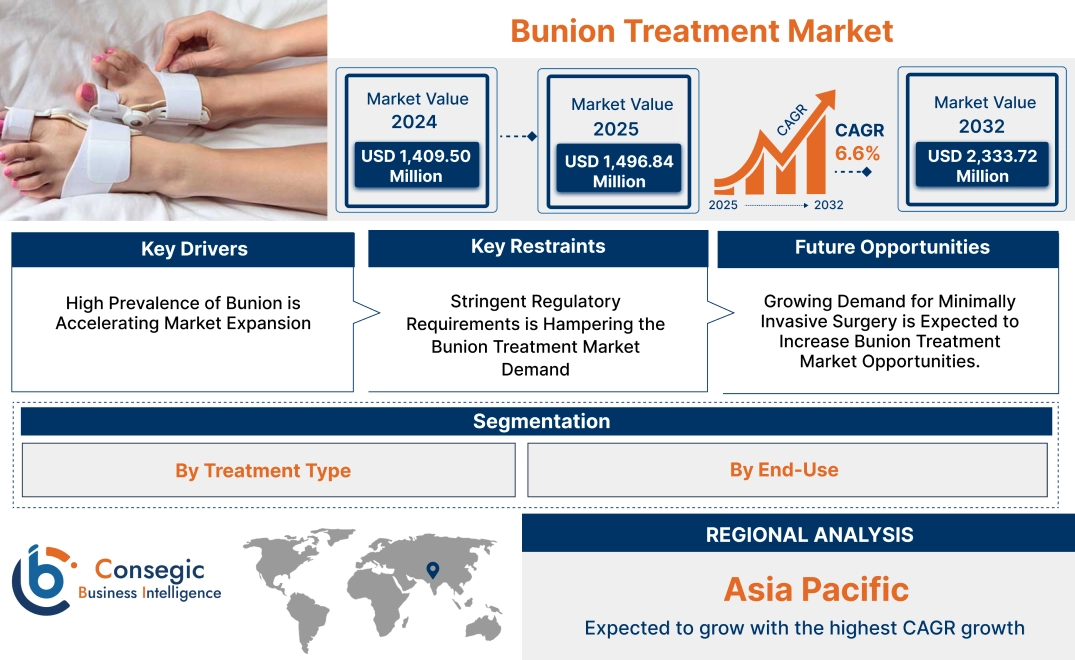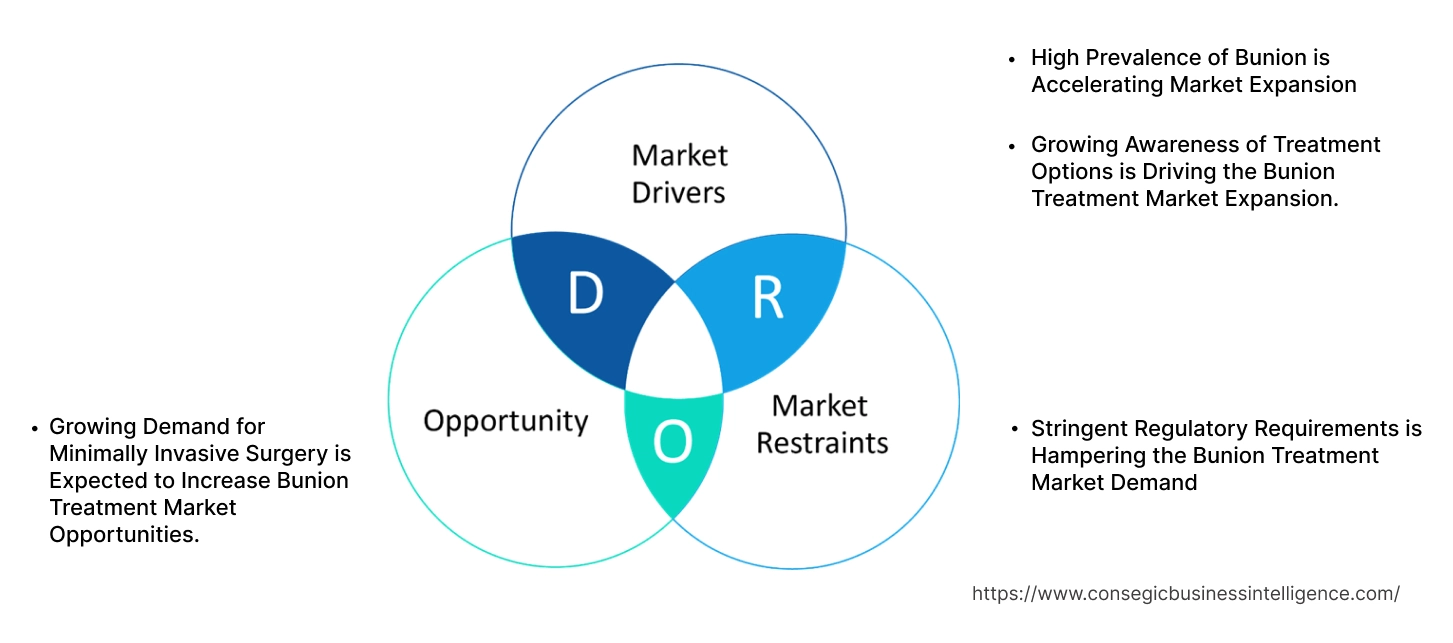- Summary
- Table Of Content
- Methodology
Bunion Treatment Market Size:
Bunion Treatment Market size is growing with a CAGR of 6.6% during the forecast period (2025-2032), and the market is projected to be valued at USD 2,333.72 Million by 2032 from USD 1,409.50 Million in 2024. Additionally, the market value for the 2025 attributes to USD 1,496.84 Million.
Bunion Treatment Market Scope & Overview:
A bunion is also known as the hallux valgus. It is a bony bump that forms at the base of the big toe. It develops when the big toe pushes against the next toe. It causes the joint to stick out. This leads to pain, swelling, and difficulty in walking. Bunions result from wearing tight shoes, arthritis, or genetic factors. Bunion treatment varies based on severity. Self-care methods include using bunion pads and applying ice to reduce pain and swelling. Medications such as ibuprofen and anti-inflammatory drugs are helping patients to relieve from discomfort. Moreover, devices such as orthotic shoe inserts, toe spacers, and splints improve foot alignment and reduce pressure. In severe cases, surgery is needed to correct the bone position. The treatment is provided in hospitals, clinics, and ambulatory surgical centers.
Key Drivers:
High Prevalence of Bunion is Accelerating Market Expansion
A bunion is deformity of the metatarsophalangeal joint which connects big toe to the foot. This misalignment causes pain, swelling, and difficulty in walking. Bunion treatment reduces pain and improves mobility. Non-surgical options such as orthotics and pain relievers provide relief without downtime. Surgery offers a permanent solution for severe cases, correcting toe alignment. Lifestyle changes, such as wearing high heels and narrow shoes, and genetic factors have led to increased cases of bunion.
For instance,
- According to a study published by the National Center for Biotechnology Information, in 2023, the estimated global prevalence of bunion is 19%. This has led to increased need for its treatment.
Overall, the high prevalence is significantly boosting the bunion treatment market expansion.
Growing Awareness of Treatment Options is Driving the Bunion Treatment Market Expansion.
More people are becoming aware of the treatment options available. This directly influences the management of the condition. The increased awareness comes from hospitals offering specialized care. Moreover, companies are promoting treatment products. This is also increasing awareness. Additionally, social media and healthcare websites on online platforms are sharing information that guide patients to manage their bunion condition.
For instance,
- Endeavor Clinical Trials published an article in 2024 stating different treatment options available to manage bunion such as using ice packs, toe exercises, using orthotic inserts, anti-inflammatory drugs and others. This has led patients to seek early treatment, driving the market share.
Thus, growing awareness of treatment options available are accelerating the global bunion treatment market growth.
Key Restraints:
Stringent Regulatory Requirements is Hampering the Bunion Treatment Market Demand
Stringent regulatory requirements are a major hurdle in the market. Medical devices such as orthotics, splints, and surgical implants are required strict approval processes before they are sold. Government agencies, such as the Food and Drug Administration in the U.S. and the European Medicines Agency in Europe, necessitate rigorous clinical trials and safety testing. This is expensive and time-consuming. Moreover, new surgical techniques also need approval. All these factors delay their availability to patients. Smaller companies struggle to meet these regulations due to high costs and complex paperwork. Additionally, there are variations in regulatory standards across different regions. For example, what is approved in one country takes additional time to another. Hence, the stringent regulatory requirements are hampering the bunion treatment market demand.
Future Opportunities :
Growing Demand for Minimally Invasive Surgery is Expected to Increase Bunion Treatment Market Opportunities.
Minimally invasive surgery (MIS) in bunion condition causes less pain, smaller scars, and faster recovery when compared to traditional surgery. It requires only small incisions. This reduces the risk of infection and complications. Patients experience minimal blood loss and walk the same day. Also, less tissue damage leads to quicker healing and a shorter hospital stay. Hospitals and clinics are adopting MIS systems as patients are increasingly requiring it due to multiple benefits.
For instance,
- In 2024, Robert Wood Johnson University Hospital started offering new minimally invasive surgery service to treat bunions. This creates potential for manufacturers to develop more solutions related to it.
Overall, growing demand for minimally invasive surgery is expected to increase bunion treatment market opportunities.
Bunion Treatment Market Segmental Analysis :
By Treatment Type:
Based on treatment type, the market is categorized into selfcare, medications, devices, and surgery.
Trends in Treatment Type:
- Patients are increasingly seeking non-surgical treatment. This includes orthotics, splints, and physical therapy before considering surgery.
- Surgeons are increasingly using minimally invasive procedures for this bunion condition. This has resulted in smaller incisions, less pain, and faster recovery.
The surgery segment accounted for the largest market share in 2024 and is expected to grow at the fastest CAGR over the forecast period.
- Surgery segment dominated the bunion treatment market trends, and it is emerging as well. Bunion surgery is a procedure to remove the bony bump and correct its alignment.
- During surgery, doctors use surgical tools, screws, plates, and wires to fix the bone in the right position.
- Advantages of surgery include pain relief, improved foot function, and better walking ability.
- There are innovations in devices with better understanding of bunion biomechanics. These are improving the effectiveness of non-surgical approaches.
- For instance, in 2024, Treace Medical launched Percuplasty Percutaneous Bunion Correction System that are used in surgical procedures for bunion treatment. It corrects deformity using 3D approach being cosmetically appealing. This has expanded the applications and reach.
- Overall, as per the market analysis, the new product innovations are driving a segment in bunion treatment market growth.
By End User:
Based on end-use, the market is categorized into hospitals, clinics, and ambulatory surgical centers (ASC).
Trends in the End-Use
- ASCs are becoming increasingly popular for bunion surgeries. It is due to their cost-effectiveness, convenience, and focus on outpatient procedures.
- Clinics are increasingly adopting advanced equipment’s to perform bunion correction surgeries.
The hospitals segment accounted for the largest market share of 66.42% in 2024.
- Hospitals segment dominated the bunion treatment market trends. This is because of their comprehensive capabilities.
- Hospitals handle the most complex bunion cases. Also, hospitals possess the necessary infrastructure and all equipment’s to perform procedures.
- They offer access to a range of specialists. This includes orthopedic surgeons, anesthesiologists, vascular surgeons, and pain management specialists.
- Additionally, hospitals have a high volume of patients. It is because of insurance coverage and referral system. Hospitals are adopting new procedures to optimize the treatment options.
- For instance, in 2024, Northern Light Inland Hospital started providing a new procedure for bunion treatment called Lapiplasty 3D bunion correction. This is increasing the treatment reach for patients.
- Overall, as per the market analysis, hospitals adopting new treatment procedures are driving segmental growth in the bunion treatment industry.
The ambulatory surgical centers segment is expected to grow at the fastest CAGR over the forecast period.
- Ambulatory surgical centers (ASCs) segment is emerging in the market trends. They generally offer bunion procedures at a lower cost compared to hospitals.
- ASCs are designed for outpatient procedures. This allows patients to have their bunion surgery and return home the same day.
- Also, ASCs also have shorter wait times for procedures compared to busy hospitals.
- Moreover, they are increasingly providing minimally invasive bunion procedures with precision and efficiency.
- The trend towards outpatient procedures is growing across various medical specialties, and bunion surgery is well-suited for this approach. This is driving the segment.
- Moreover, as per the market analysis, the rising prevalence of bunion will drive the segmental growth for the forecasted years.
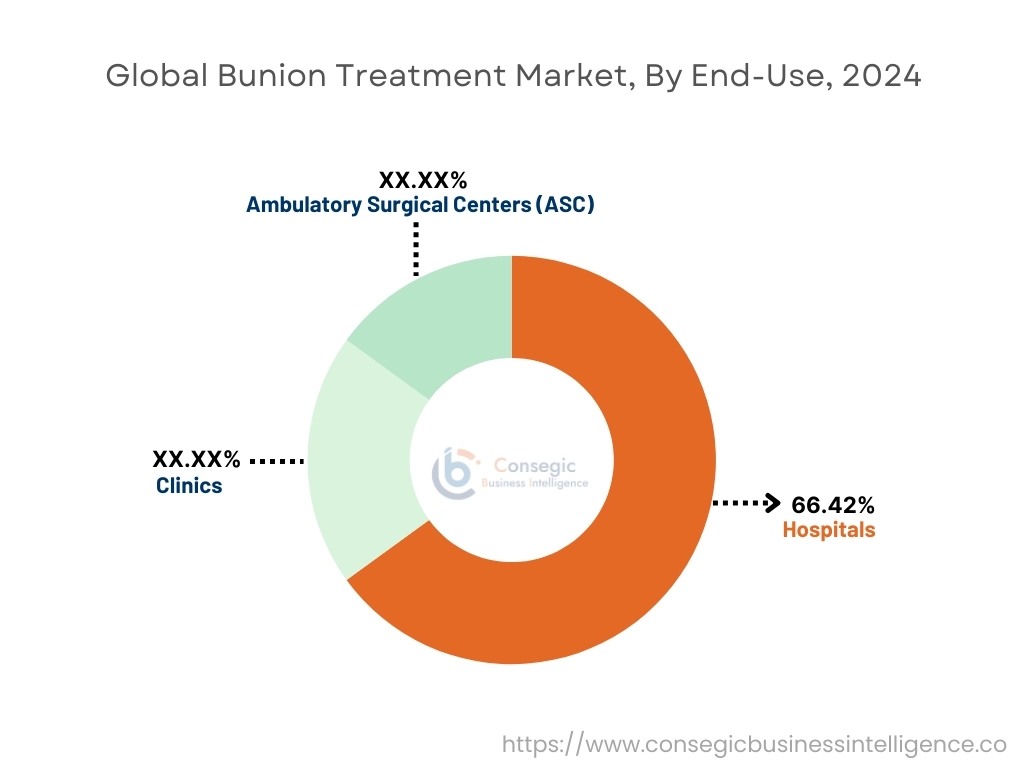
Regional Analysis:
The regional segment includes North America, Europe, Asia Pacific, the Middle East and Africa, and Latin America. Factors such as aging, obesity, and wearing tight or shoes are increasing bunion cases in region.
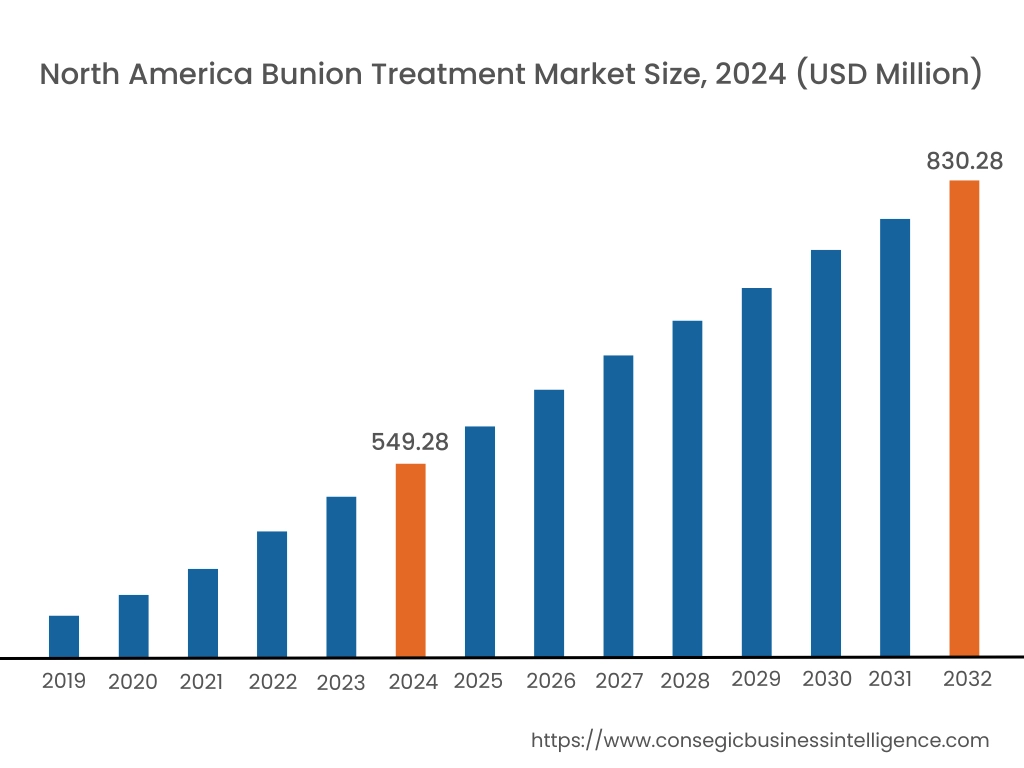
In 2024, North America accounted for the highest bunion treatment market share at 38.97% and was valued at USD 549.28 Million and is expected to reach USD 830.28 Million in 2032. In North America, the U.S. accounted for the bunion treatment market share of 73.17% during the base year of 2024. Factors such as aging, obesity, and wearing tight or high-heeled shoes are increasing bunion cases. Owing to this, many people are experiencing pain and difficulty walking. This is leading to higher demand for treatment options such as orthotics, medications, and surgery. Moreover, as per the market analysis, companies are developing advanced orthotic devices. This includes bunion splints, and minimally invasive surgical techniques to improve treatment outcomes.
For instance,
- In 2024, Paragon 28 launched Precision MIS Bunion System designed to correct bunions by allowing for precise, tri-planar correction of the metatarsal head through a guided outrigger. This is enabling more surgeons to perform treatment on patients.
Overall, the rising prevalence of bunions, and technological advancements are driving the market in the region.
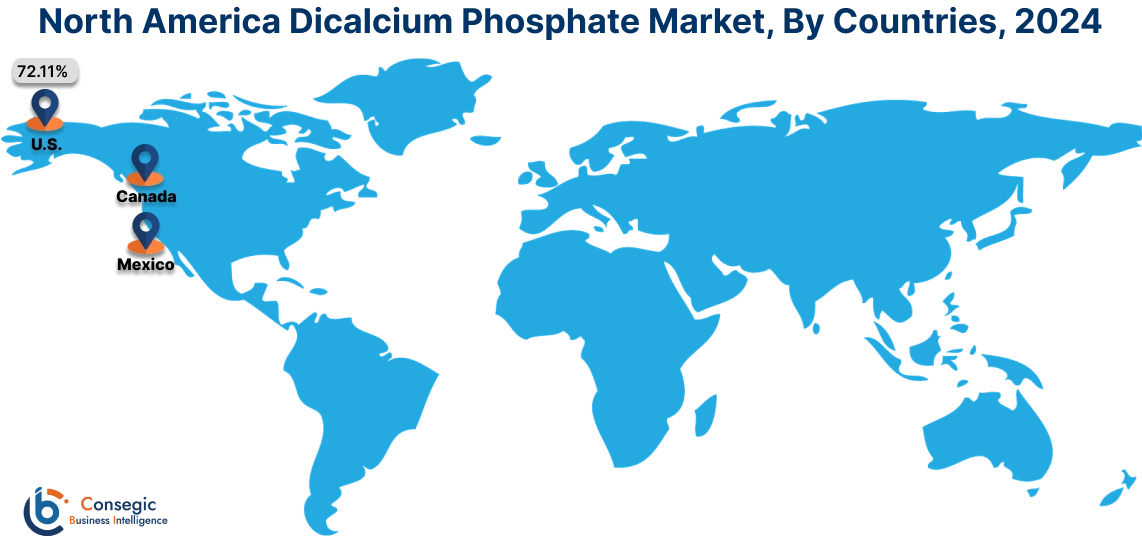
In Asia Pacific, the bunion treatment market is experiencing the fastest growth with a CAGR of 9% over the forecast period. Countries such as Japan, China, and India have a rising number of geriatric populations who require treatment for bunion foot conditions. This is leading to higher demand for orthotics, medications, and surgical procedures to relieve pain and improve mobility. Moreover, more people are learning about early treatment options through online platforms, and healthcare campaigns. Companies are also promoting new orthotic devices, pain relief solutions, and minimally invasive surgeries. This is encouraging more patients to seek medical help. The growth of e-commerce and telemedicine has made it easier for people to access treatment information and buy bunion care products, further driving market in the region.
Europe's bunion treatment market analysis states that several trends are responsible for the progress of the market in the region. Many countries, including Germany, France, and the UK, have strong healthcare systems where insurance cover’s part or all of the treatment cost. This makes surgical procedures, medications, and orthotic devices more affordable for patients. With better financial support, more people are choosing medical treatment instead of delaying care due to cost concerns. Moreover, there is a rising trend for minimally invasive surgeries. These procedures cause less pain, smaller scars, and faster recovery compared to traditional surgery. Many clinics in Europe now offer advanced surgical techniques, making treatment more accessible.
The Middle East and Africa (MEA) bunion treatment market analysis states that the region is also witnessing several trends for notable surge. Many countries, such as Saudi Arabia, the UAE, and South Africa, are investing in better hospitals. More specialized foot care centers and podiatrists are now available. This is making it easier for patients to get treatment. Moreover, more people are choosing personalized insoles and foot supports to relieve pain and prevent bunions from worsening. Advances in 3D scanning and printing technology have made orthotics more effective and comfortable.
Latin America's bunion treatment market size is also emerging. Many countries, such as Brazil, Mexico, and Argentina, governments are increasing the healthcare industry spending. This allows for higher expenses allocated to healthcare facilities. They are adopting advanced systems for treatment. Some governments are also expanding health insurance coverage. This is making it easier for people to access treatment without high costs. Moreover, medical device manufacturers are working with healthcare facilities and research institutions to develop advanced treatment options. Many companies are also teaming up with local distributors and e-commerce platforms to make bunion care products more available.
Top Key Players and Market Share Insights:
The Bunion Treatment market is highly competitive with major players providing products to the national and international markets. Key players are adopting several strategies in research and development (R&D) and product innovation to hold a strong position in the global Bunion Treatment market. Key players in The Bunion Treatment industry include-
- Stryker Corporation (U.S.)
- Paragon 28 (U.S.)
- Arthrex (U.S.)
- CONMED Corporation (U.S.)
- Deva Tibbi (Turkey)
- Enovis Corporation (U.S.)
- Johnson & Johnson (U.S.)
- Astrolabe Medical (Portugal)
- Zimmer Biomet (U.S.)
- Medartis AG (Switzerland)
- Treace Medical (U.S.)
- Merete GmbH (Germany)
Recent Industry Developments :
Product Launches:
- In February 2024, Paragon 28 launched the Precision MIS Bunion System. It allows for tri-planar correction of a bunion through a minimally invasive surgical technique. The system includes instrumentation and screws to facilitate correction and fixation of a bunion using cannulated screws.
- In September 2024, Stryker launched PROstep MIS Lapidusa system. It is designed to treat bunions by correcting hallux valgus deformity through small incisions. It offers benefits such as faster recovery, less pain, smaller scars.
Bunion Treatment Market Report Insights :
| Report Attributes | Report Details |
| Study Timeline | 2019-2032 |
| Market Size in 2032 | USD 2,333.72 Million |
| CAGR (2025-2032) | 6.6% |
| By Treatment Type |
|
| By End User |
|
| By Region |
|
| Key Players |
|
| North America | U.S. Canada Mexico |
| Europe | U.K. Germany France Spain Italy Russia Benelux Rest of Europe |
| APAC | China South Korea Japan India Australia ASEAN Rest of Asia-Pacific |
| Middle East and Africa | GCC Turkey South Africa Rest of MEA |
| LATAM | Brazil Argentina Chile Rest of LATAM |
| Report Coverage |
|
Key Questions Answered in the Report
How big is the Bunion Treatment market? +
In 2024, the Bunion Treatment market is USD 1,409.50 Million.
Which is the fastest-growing region in the Bunion Treatment market? +
Asia Pacific is the fastest-growing region in the Bunion Treatment market.
What specific segmentation details are covered in the Bunion Treatment market? +
Treatment Type and End-Use segmentation details are covered in the Bunion Treatment market
Who are the major players in the Bunion Treatment market? +
Stryker Corporation (U.S.), Paragon 28 (U.S.), Johnson & Johnson (U.S.), Astrolabe Medical (Portugal), Zimmer Biomet (U.S.), and Medartis AG (Switzerland) are some major players in the market.
